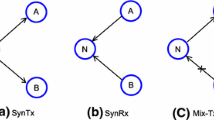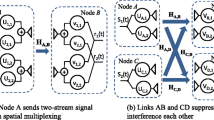Abstract
In this study, the performance of a WDM LAN of passive star topology is explored. An effective synchronous transmission WDMA protocol is proposed that employs a pre-transmission reservation scheme in order to improve the system output. Each station is equipped with a network interface with more than one tunable receivers in order to be able to receive more than one data packets during a time frame. As a results, the average probability of packet rejection at destination is significantly reduced as compared with the single tunable receiver per station case. The system performance is mathematically modelled based on Poisson statistics and finite station population. Also, an analytical framework is adopted to evaluate the effect of the number of tunable receivers per station on the total performance. Numerical results are comparatively studied for various numbers of data channels and stations. Finally, the propagation delay latency parameter is properly modelled while its impact on the system performance is analytically evaluated.
Access this chapter
Tax calculation will be finalised at checkout
Purchases are for personal use only
Similar content being viewed by others
References
Zheng, J., Mouftah, H.T.: Optical WDM Networks: Concepts and Design Principles. Wiley, IEEE Press, New York (2004)
Pountourakis, I.E.: Performance evaluation with receiver collisions analysis in very high-speed optical fiber local area networks using passive star topology. IEEE J. Lightwave Technol. 16(12), 2303–2310 (1998)
Baziana, P.A.: An approximate protocol analysis with performance optimization for WDM. Optical Fiber Technol. 20(4), 414–421 (2014)
Baziana, P.A., Pountourakis, I.E.: Performance optimization with propagation delay analysis in WDM networks. Comput. Commun. 30(18), 3572–3585 (2007)
Baziana, P.A., Pountourakis, I.E.: A transmission strategy with protocol analysis for performance improvement in WDM networks. IEEE Trans. Commun. 60(7), 1975–1985 (2012)
Bengi, K., van As, H.: Efficient QoS support in a slotted multihop WDM metro ring. IEEE J. Select. Areas Commun. 20, 216–227 (2002)
Bengi, K.: Access protocols for an efficient and fair packet-switched IP-over-WDM metro network. Comput. Netw. 44, 247–265 (2004)
Bregni, S., et al.: Slot synchronization of WDM packet-switched slotted rings: the WONDER project. In: Proceedings of the ICC 2006 International Conference Communications, Istanbul, Turkey, pp. 2556–2561, 11–15 June 2006
Herzog, M., et al.: Metropolitan area packet-switched WDM networks: a survey on ring systems. IEEE Commun. Surveys and Tutorials 6, 2–20 (2004)
Yang, H., et al.: Metro WDM networks: performance comparison of slotted ring and AWG star networks. IEEE J. Select. Areas Commun. 22, 1460–1473 (2004)
Baziana, P.A., Pountourakis, I.E.: An efficient metropolitan WDM ring architecture for a slotted transmission technique. IEEE J. Lightwave Technol. 26(19), 3307–3317 (2008)
Baziana, P.A., Pountourakis, I.E.: An input traffic allocation strategy and an efficient transmission technique for collisions-free WDM ring MANs. Opt. Fiber Technol. 16(5), 279–291 (2010)
Turuk, A., Kumar, R.: A scalable and collision-free MAC protocol for all-optical ring networks. Comput. Commun. 27, 1453–1463 (2004)
Turuk, A., Kumar, R.: QoS provisioning in WDM ring networks with tunable transceivers. J. High Speed Netw. 14, 317–339 (2005)
Turuk, A., et al.: A token-based distributed algorithm for medium access in an optical ring network. Optics Commun. 231, 199–212 (2004)
MacGregor, M., et al.: The relative utility of three optical network properties in future dynamic optical networks. In: Proceedings of the IASTED WOC 2002 Wireless and Optical Communications, Banff, Alberta, Canada, pp. 191–195, 17–19 July 2002
Baziana, P.A.: Performance analysis of a WDMA protocol with a multiple tunable receivers node architecture for high-speed optical fiber LANs. In: Proceedings of the 6th International Conference on Optical Communication Systems 2015 (OPTICS 2015), pp. 5–13, Colmar, France, 20–22 July 2015
Sudhakar, G.N.M., et al.: Slotted aloha and reservation aloha protocols for very high-speed optical fiber local area networks using passive star topology. IEEE J. Lightwave Technol. 9(10), 1411–1422 (1991)
Feller, W.: An Introduction to Probability Theory and Its Applications. Wiley, New York (1968)
Wentzel, E., Ovcharov, L.: Applied Problems In Probability Theory. Mir Publishers, Moscow (1986)
Author information
Authors and Affiliations
Corresponding author
Editor information
Editors and Affiliations
Appendix
Appendix
We assume the model that consists of N data channels and M stations. We aim to analytically describe the distribution of the successfully transmitted data packets over the N data channels to the M stations. This model corresponds to the occupancy problem of the distribution of indistinguishable balls (data packets) to cells (destination stations), supposing that the arrangements should have equal probabilities. We consider indistinguishable packets transmitted to indistinguishable destination stations using Maxwell-Boltzman statistics [19].
We are interested in the probability \( \Pr [A_{N} (s) = r] \) of r correctly received data packets at destination when s data packets have been successfully transmitted over the N-channel system, during a time frame, 1 ≤ s.
Let’s suppose that each station may transmit to any of the M stations (for the sake of generality we suppose that a station may send to and receive from itself). According to the Maxwell-Boltzman statistics, there are \( M^{s} \) possible arrangements of the s successfully transmitted data packets to the M destination stations, each with equal and constant probability: \( 1/M^{s} \).
We consider that the distribution of s data packets to M stations provides the following result by the end of a frame:
-
there are k 0 of M destination stations, \( k_{0} \in \left\{ {0,1,2, \ldots ,M} \right\} \): for each of them there is no successfully transmitted data packet destined to it,
-
there are k 1 of M destination stations, \( k_{1} \in \left\{ {0,1,2, \ldots ,s} \right\} \): for each of them there is 1 successfully transmitted data packet destined to it, and so on. In general,
-
there are k i of M destination stations, \( i,k_{i} \in \left\{ {1,2, \ldots ,s} \right\} \): for each of them there are i successfully transmitted data packets destined to it.
It is obvious that:
and:
Since each destination station is capable of receiving up to x data packets per frame, it is:
For each set of integers \( \left\{ {k_{0} ,k_{1} ,k_{2} , \ldots ,k_{M} } \right\} \) that satisfy Eqs. (14), (15), and (16) and it is \( k_{0} ,k_{1} , \ldots k_{M} \in \left\{ {0,1,2, \ldots ,M} \right\} \), the probability P ki that: no data packet is destined to k 0 stations, one data packet is destined to k 1 stations, and so on; and generally, i data packets are destined to k i stations is given in [20]:
Thus, the probability \( \Pr [A_{N} (s) = r] \) is defined as the sum of the probabilities P ki , for all possible sets of integers \( \left\{ {k_{0} ,k_{1} ,k_{2} , \ldots ,k_{M} } \right\} \) that satisfy Eqs. (14), (15), and (16) and it is \( k_{0} ,k_{1} , \ldots k_{M} \in \left\{ {0,1,2, \ldots ,M} \right\} \), i.e.:
Rights and permissions
Copyright information
© 2016 Springer International Publishing Switzerland
About this paper
Cite this paper
Baziana, P.A. (2016). How Do the Multiple Tunable Receivers Per Node Affect the Efficiency of a WDM LAN? A Performance Analytical Study. In: Obaidat, M., Lorenz, P. (eds) E-Business and Telecommunications. ICETE 2015. Communications in Computer and Information Science, vol 585. Springer, Cham. https://doi.org/10.1007/978-3-319-30222-5_8
Download citation
DOI: https://doi.org/10.1007/978-3-319-30222-5_8
Published:
Publisher Name: Springer, Cham
Print ISBN: 978-3-319-30221-8
Online ISBN: 978-3-319-30222-5
eBook Packages: Computer ScienceComputer Science (R0)




